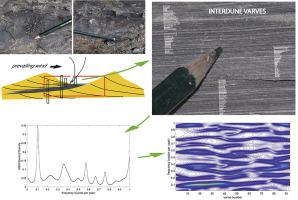Geoscience Frontiers ( IF 8.9 ) Pub Date : 2020-08-05 , DOI: 10.1016/j.gsf.2020.06.008 Juan Pedro Rodríguez-López , Eduardo Barrón , Daniel Peyrot , Gary B. Hughes

|
Many oases (wet interdunes) are sedimentary systems characterized by high-frequency water-level oscillations, marked changes in salinity and intense biological activity at their margins. They are considered to be one of the most challenging environments on Earth for ecosystem development. These dynamic, depositional settings are usually unfavourable for fossilization and subsequent preservation of vegetal remains. This paper describes bryophyte (liverwort) assemblages occurring in three successive horizons interpreted to represent (i) recurrent early successional phases of biological soil crust colonization of wet interdune margins or (ii) exceptional preservation of floating or riparian liverworts in oasis pond waters associated with a progressive fall of the interdune water level. The record of in situ colonization surfaces characterized by delicate (e.g. lignin-free) three-dimensional structures represents an exceptional type of preservation herein associated with a rapid variation in phreatic interdune water level and the subsequent establishment of anoxic and reducing conditions. The occurrence of exceptionally preserved liverwort colonies coincides with the sedimentary record of, at least, three seismite levels in the oasis. Data gathered from the site suggests that the water table of the oasis was controlled by a combination of (i) a positive creation of accommodation space due to subsidence associated with movement on syn-sedimentary extensional faults, and (ii) the rise and fall of the oasis water table controlled by the oscillations of the groundwater system due to orbital changes which appear to drive the variability of the climate system. Rising groundwater levels flooded the oasis soil crusts and lead to the exceptional recurrent preservation of liverwort colonies at the oasis margins. Alternatively, considering the hypothesis of floating or riparian liverworts in the oasis pond waters, the fall in the level of the oasis water table placed the floating liverworts in contact with the oasis bottom sediments. This fall in the level of the oasis water table could indicate a cessation of accommodation space by syn-sedimentary extensional faults and/or a regional lowering of the groundwater system level associated with drought periods. Preliminary results indicate that oasis lamination between liverwort colonies records decadal and sub-decadal cyclicity, related with 11-year Schwabe sunspot and sub-decadal NAO cyclicities, conferring for every sedimentary cycle between liverwort colonies a duration of approximately 200 years, that otherwise matches the expected recurrence period for the De Vries cycle of solar activity.
中文翻译:

致命的绿洲:白垩纪沙漠苔藓植物群落的反复灭绝;太阳,气候和岩石圈强迫的作用
许多绿洲(湿的interdunes)是沉积系统,其特征是高频水位振荡,盐度的明显变化和其边缘的强烈生物活性。它们被认为是地球上生态系统发展最具挑战性的环境之一。这些动态的沉积环境通常不利于化石和随后保存植物残骸。本文描述了在三个连续的视野中发生的苔藓植物(利福草)组合,这些苔藓植物被解释为代表(i)湿润中间边缘的生物土壤地壳定殖的周期性早期演替阶段,或(ii)与绿洲池塘水相关的浮游或河岸艾蒿的特殊保存。中间水位逐渐下降。原位记录以精细的(例如,无木质素)三维结构为特征的定殖表面代表本文中特殊的保存类型,其与潜水间水位的快速变化以及随后的缺氧和还原条件的建立有关。极具保存价值的艾蒿汁菌落的出现与绿洲中至少三个地震岩层的沉积记录相吻合。从现场收集的数据表明,绿洲的地下水位受以下因素的组合控制:(i)由于同沉积沉积伸展运动引起的沉降相关的积极沉降,形成了积极的居住空间,(ii)绿洲地下水位的上升和下降是由于轨道变化引起的地下水系统振荡控制的,而轨道变化似乎驱动了气候系统的变化。不断上升的地下水位淹没了绿洲土壤结皮,并导致在绿洲边缘特异地反复保存了艾蒿群落。另外,考虑到绿洲池塘水域中漂浮的或河岸的艾蒿的假说,绿洲地下水位的下降使漂浮的艾蒿与绿洲的底部沉积物接触。绿洲地下水位的下降可能表明同沉积的伸展性断层和/或与干旱时期有关的地下水系统水平的区域性下降导致居住空间的减少。


























 京公网安备 11010802027423号
京公网安备 11010802027423号